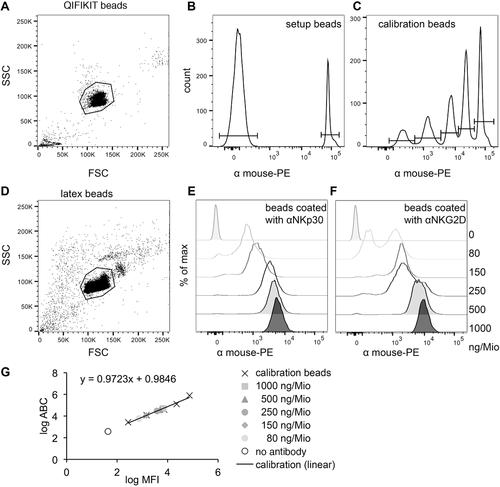{"title":"Coated Latex Beads as Artificial Cells for Quantitative Investigations of Receptor/Ligand Interactions","authors":"Doris Urlaub, Carsten Watzl","doi":"10.1002/cpim.111","DOIUrl":null,"url":null,"abstract":"<p>Cellular interactions are often essential to regulate immune cell activities during an immune response. To understand the details of this process, it is necessary to study individual receptor/ligand interactions in a quantitative fashion. However, this is often very difficult or even impossible when using real cells for stimulation. Here, we present a method to use cell-sized latex beads for such studies. These beads can be coated with agonistic antibodies or specific ligands in a defined and quantifiable fashion. This creates the possibility of titrating the strength of the stimulation for a specific receptor in a three-dimensional system. Using natural killer (NK) cells as an example, we demonstrate how these beads can be used to stimulate NK cell responses. © 2020 The Authors.</p><p><b>Basic Protocol 1</b>: Covalent coating of latex beads with antibodies</p><p><b>Basic Protocol 2</b>: Quantification of the amount of antibodies on the beads with the QIFIKIT<sup>®</sup></p><p><b>Alternate Protocol 1</b>: Covalent coating of latex beads with streptavidin to bind biotinylated proteins</p><p><b>Alternate Protocol 2</b>: Quantification of the amount of protein on the beads with the QIFIKIT<sup>®</sup></p><p><b>Support Protocol</b>: Functional testing of the beads in a natural killer cell degranulation assay</p>","PeriodicalId":10733,"journal":{"name":"Current Protocols in Immunology","volume":"131 1","pages":""},"PeriodicalIF":0.0000,"publicationDate":"2020-11-04","publicationTypes":"Journal Article","fieldsOfStudy":null,"isOpenAccess":false,"openAccessPdf":"https://sci-hub-pdf.com/10.1002/cpim.111","citationCount":"2","resultStr":null,"platform":"Semanticscholar","paperid":null,"PeriodicalName":"Current Protocols in Immunology","FirstCategoryId":"1085","ListUrlMain":"https://onlinelibrary.wiley.com/doi/10.1002/cpim.111","RegionNum":0,"RegionCategory":null,"ArticlePicture":[],"TitleCN":null,"AbstractTextCN":null,"PMCID":null,"EPubDate":"","PubModel":"","JCR":"Q2","JCRName":"Immunology and Microbiology","Score":null,"Total":0}
引用次数: 2
Abstract
Cellular interactions are often essential to regulate immune cell activities during an immune response. To understand the details of this process, it is necessary to study individual receptor/ligand interactions in a quantitative fashion. However, this is often very difficult or even impossible when using real cells for stimulation. Here, we present a method to use cell-sized latex beads for such studies. These beads can be coated with agonistic antibodies or specific ligands in a defined and quantifiable fashion. This creates the possibility of titrating the strength of the stimulation for a specific receptor in a three-dimensional system. Using natural killer (NK) cells as an example, we demonstrate how these beads can be used to stimulate NK cell responses. © 2020 The Authors.
Basic Protocol 1: Covalent coating of latex beads with antibodies
Basic Protocol 2: Quantification of the amount of antibodies on the beads with the QIFIKIT®
Alternate Protocol 1: Covalent coating of latex beads with streptavidin to bind biotinylated proteins
Alternate Protocol 2: Quantification of the amount of protein on the beads with the QIFIKIT®
Support Protocol: Functional testing of the beads in a natural killer cell degranulation assay

包膜乳胶珠作为人工细胞用于受体/配体相互作用的定量研究
在免疫应答过程中,细胞间的相互作用往往是调节免疫细胞活动所必需的。为了了解这一过程的细节,有必要以定量的方式研究单个受体/配体的相互作用。然而,当使用真实细胞进行刺激时,这通常是非常困难甚至不可能的。在这里,我们提出了一种使用细胞大小的乳胶珠进行此类研究的方法。这些小珠可以以确定的和可量化的方式涂覆激动性抗体或特定配体。这创造了在三维系统中滴定特定受体的刺激强度的可能性。以自然杀伤(NK)细胞为例,我们展示了这些珠子如何用于刺激NK细胞反应。©2020作者。基本方案1:用抗体对乳胶珠进行共价包衣基本方案2:用QIFIKIT®对乳胶珠进行共价包衣以结合生物素化蛋白替代方案1:用QIFIKIT®支持方案对乳胶珠进行蛋白量的定量:在自然杀伤细胞脱粒试验中对乳胶珠进行功能测试
本文章由计算机程序翻译,如有差异,请以英文原文为准。


 求助内容:
求助内容: 应助结果提醒方式:
应助结果提醒方式:


